Ch. 8 - Apply Smarter Not Harder: Understand Your Competitiveness
Let’s get to the burning question that every applicant asks: How competitive am I? While a book chapter can never replace an EM-specific advisor who is familiar with your application’s strengths and weaknesses, we do have survey and analytical data from the NRMP and residency program leadership1-13 to help you better assess your level of competitiveness, thereby helping you apply to residency in a more informed and confident manner. Take a deep breath — while every applicant has their strengths and weakness, the vast majority of applicants fall into the competitive category, so it is likely that you do, too!
What is competitiveness in the EM match?
Competitiveness is your ability to match; this closely correlates with the likelihood of obtaining enough interviews to match. EM competitiveness is influenced through tangible factors such as grades, board scores, class rank, and letters of recommendation and can be qualified based on nationally available data. Your ultimate success in the match is greatly affected by your application strategy, which requires careful consideration with an EM-specific advisor.
What is the difference between being nationally, regionally, or locally competitive?
Local competitiveness is difficult to predict. Your competitiveness within a specific locality or hospital may center around personal relationships, which have developed over time, in addition to more standardized qualifications such as national board scores and letters of recommendation. Moreover, individual programs will emphasize different application components that might change how competitive you are within that locality. You can ask your academic advisor for insight.
Regional competitiveness might be influenced by relationships but may also be influenced by a rotation or letter of recommendation generated from a rotation within that same region. Program leadership places increased influence upon letters and evaluators with which they are familiar — in a 2014 program director survey, 97% of respondents agreed that, “Knowing the person who wrote the SLOR [now known as the SLOE] increases its value to my decision-making.”8 While some programs within a region share some of the same preferences or priorities when selecting candidates,9 not all do, thus making regional competitiveness also challenging to predict.
National competitiveness is broader but easier to qualify in terms of common residency application components, including grades, board scores, class rank, and letters of recommendation. National data on competitiveness presented in this document represent data that historically have predicted a successful match into EM and the preferences and general consensus opinion of those individuals who are involved in allocating interviews and generating rank lists at EM residency programs.
Osteopathic and IMG Students: See Chapter 4: Finding Your Fit: Choosing Where to Apply, Figure 4.2 for information about which states historically match the most osteopathic and IMG applicants. By focusing applications where there are both more programs and more spots, osteopathic and IMG applicants can maximize their opportunities to match.
Filters & Their Role in Your Competitiveness
As mentioned above, your ability to match closely correlates with the likelihood of obtaining enough interviews to match. As the number of residency applications per medical student increase each year, residency programs need to find ways to wade through the increasing number of applications they receive. One of the solutions employed by a little more than half of programs (54%) is applying screening filters to help determine which files to review further for interview offer.15 Figure 8.1 details the most commonly used filters and the relative frequencies of screening filter use by programs that report using filters.13
While program directors still give board scores a lower importance rating than SLOEs, grades in EM, and EM rotation performance when determining who to offer interviews (3.8/5 compared to 4.8, 4.5 and 4.5, respectively)5, approximately 55% of programs in the survey from Figure 8.1 report using filters for Step 1 failure and a Step 1 “minimum score.”13 According to the 2018 NRMP PD Survey, 62% indicated they wanted program candidates to have a target score when deciding which applicants to interview.5 EMRA Match shows 41% of programs reported using a cutoff and 15% of programs declined to disclose whether or not they use a cutoff.11 In another survey, 10% of programs require a USMLE Step 1 score of greater than 220 to offer an applicant an interview.9
Therefore, your board scores are important! But you’ll soon see that this is just one piece of the puzzle in determining your overall competitiveness.
FIGURE 8.1. Relative Frequencies of Screening Filter Type by the 54% of EM Programs that Report to Using Them (n=71)13
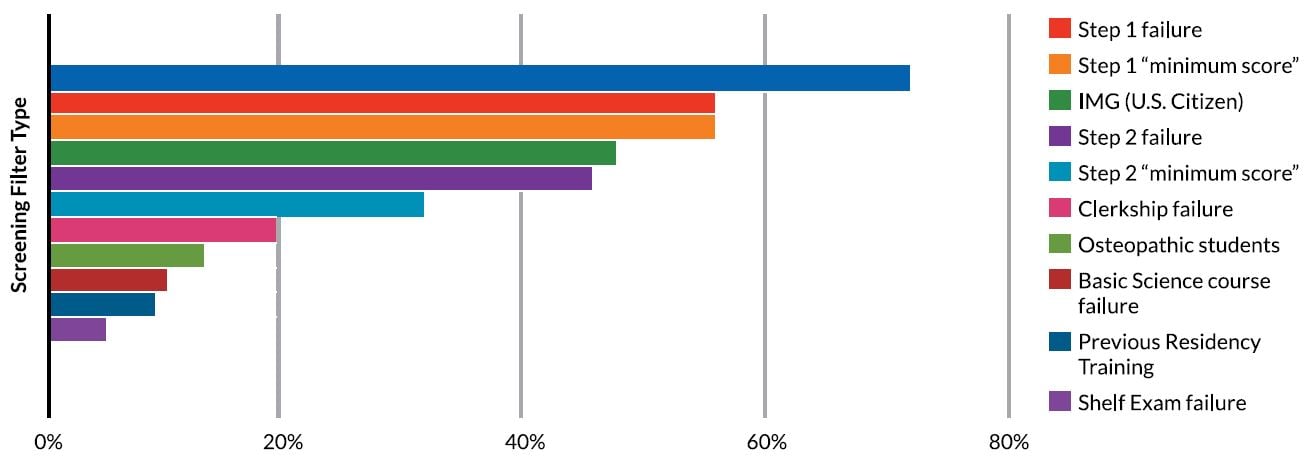
IMG Students: The most frequently used filter reported by programs is IMG (Not U.S. Citizen) — reported by >70% of programs. Target the majority of your applications towards programs that have historically accepted IMG applicants into their program — this can be searched on EMRA Match.
Osteopathic Students: The 2018 NRMP program director survey showed that 81% of ACGME program directors will offer interviews to osteopathic students.5 In the 2018 NRMP Match, 81.6% of U.S. Osteopathic Seniors applying to EM matched, compared to 91% of their allopathic peers.2 These match rates do not include students who participated in the AOA match, and it will be difficult to know if a true difference in match rates exists until all programs have transitioned to ACGME accreditation and participate in the same match.
At-Risk Candidates: If you have a USMLE score < 225, use a search engine such as EMRA Match to identify programs that are unlikely to filter out your application based on this single criterion. A declared Step 1 cutoff score does not mean an applicant with a lower score should absolutely not apply to that program, but rather that the applicant should be realistic about having a lower chance of obtaining an interview invitation there. If you are an applicant who has the potential to be filtered out by more than one of the reported filters in Figure 8.1, you likely fall into the Marginally Competitive category (see below). It is extremely important that you meet with an EM-specific advisor to discuss a possible parallel plan.
Which factors are most influential in increasing candidate competitiveness?
There is a difference between the factors that will help you garner the interview and the factors that affect your position on a residency program’s rank list (Figure 8.2).5 The SLOE and related factors (such as grades in your EM clerkships and EM rotation performances) are highly influential in both interview offer and ranking.5,9 It is important to recognize that some of the other factors that affect your chances of an interview offer may not be as influential in final ranking (for example, board scores). After you get your foot in the door, interpersonal skills and interactions with individuals on your interview are the most influential components in ranking. See Figure 8.2 for further delineation of factors that are important in selecting applicants for interview offer versus factors that are important in ranking applicants.
FIGURE 8.2. Top 10 factors program directors use in selecting applicants to interview and in ranking5
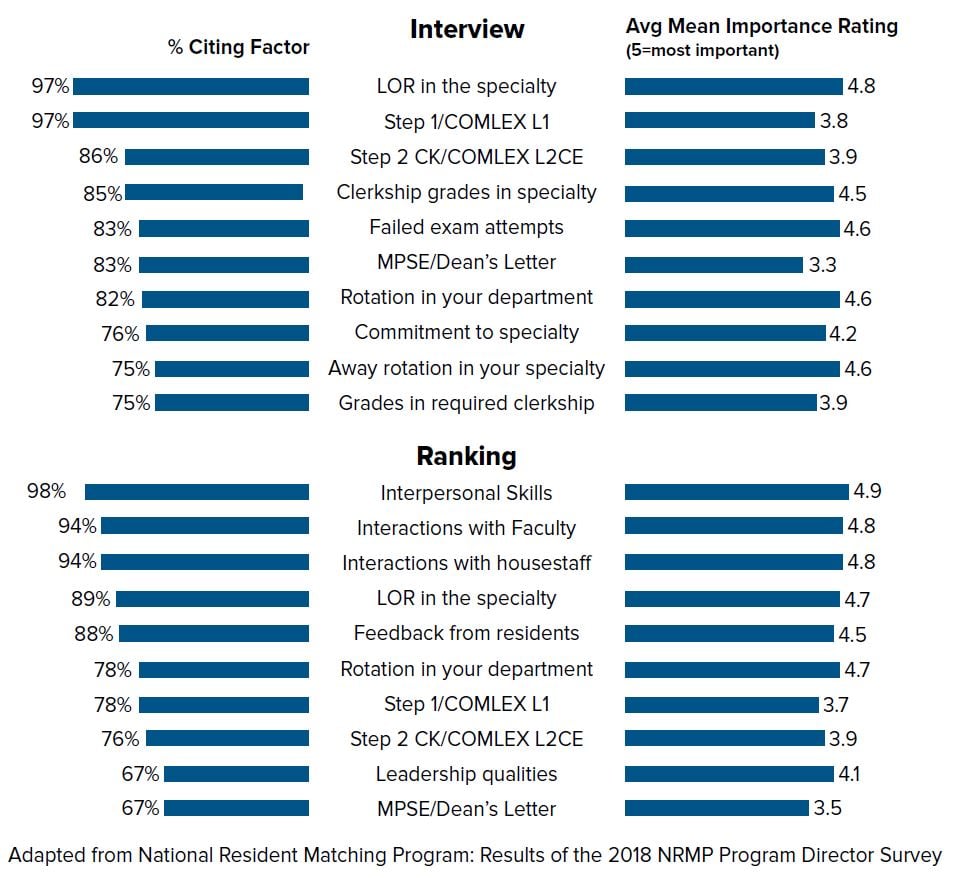
Military Match: Most military programs state the audition rotation is the MOST important factor in a student’s application.
Latecomers: An away rotation is also a month-long interview. If you have the opportunity to rotate with a program, you are evaluated by your future colleagues on a daily basis. This opportunity to work with you has been ranked a 4.6/5 by program directors in extending interviews.1 Only SLOEs ranked higher in the 2018 survey.5
Moderately influential factors in invitings applicants to interview included:
- Personal knowledge of the applicant
- Evidence of professionalism and ethics
- Leadership qualities
- AOA membership
- The percentage of individuals who were AOA members who matched into EM was 12.4% while the percentage of AOA members among those who didn’t match into EM was 0.7%, suggesting that AOA members are more competitive, but that AOA designation does not guarantee a match.1
- Perceived interest in the program
- MSPE (also known as the “Dean’s Letter”)
- Medical school reputation
- The percentage of individuals matching into EM who came from a “Top 40” medical school as it relates to NIH funding was 27.6% and was 19.9% for those not matching, again suggesting that the name or reputation of a school may influence a candidate’s competitiveness.1
Less influential components included:
- Overall or mean number of research experiences
- Overall or mean number of abstracts5
- Overall or mean number of presentations or publications5
- Overall or mean number of work experiences or volunteer experiences5
- The percentage of individuals who had obtained a PhD or other degree did not remarkably differ between those who matched and those who did not.
Which factors are most influential in decreasing candidate competitiveness?
- Any failed attempt on a USMLE/COMLEX exam
- Low grades in an EM clerkship
The SLOE seems to hold a lot of influence, but I can’t read it. How do I evaluate the competitiveness of my SLOE?
SLOEs are routinely rated highly in terms of impact in selecting candidates for interviews.5,6,9 However, candidates usually forego the right to read the letters. It would be improper to ask a letter writer or a program to disclose the information on the SLOE or to specifically ask where a candidate is likely to be ranked. Therefore, we recommend asking the letter writer for a full evaluation at the end of the rotation, including a grade, and asking how well that grade and the overall performance compares to others who have rotated this year or last year. We also recommend asking the letter writer about the anticipated level of support for their candidacy, as this approach maintains professional integrity, but also informs the candidate of his or her anticipated competitiveness.
At-Risk Candidates: Rather than simply asking for a SLOE, be more specific and ask if the letter writer is able to write a supportive SLOE. This opens a dialogue that could help you understand your competitiveness.
How many SLOEs do I need to be competitive? Do more of them make me more competitive?
Depending on some predetermined factors, most candidates in the range from Competitive to Very Competitive will be advised to do 2 EM rotations at an institution with an EM residency program, and candidates in the Less Competitive range will be advised to do 2–3. There is rarely a reason to do 4 or more EM rotations. It is generally expected to obtain a SLOE from each of these rotations.
Unfortunately, some individuals get advised to do as many EM rotations as possible. However more does not necessarily translate to better. Performing at a high level consistently on 3, 4, or 5 EM rotations takes a lot of effort and stamina. Expectations for each subsequent EM rotation are likely to be very high, as you will be expected to have accumulated a lot of experience at that point. There is also a point of diminishing returns where you may be viewed as an over-achiever or as though you’re trying to overcompensate for another part of your application. EM is a community that attempts to support its members, and when you elect to perform 4–5 clerkship rotations, you selfishly keep others from participating, violating the community-centered principle. Program directors look for these patterns and recognize these behaviors. It is not uncommon for PDs to question candidates who complete more than 3 rotations.
Osteopathic and IMG Students: If you are only able to obtain one academic rotation due to lack of a home rotation, make the absolute MOST of it to obtain the strongest SLOE possible. Use EMRA Match to help determine programs’ willingness to offer an interview with one SLOE.
Do the timing of my SLOEs influence my competitiveness?
While it is ideal that 2 SLOEs are present in the application at the time of submission, many programs recognize you cannot always complete 2 EM rotations and obtain SLOEs by the mid-September deadline. EMRA Match identifies programs willing to offer an interview with 0, 1, or 2 SLOEs; use this data if you will not have a second SLOE available by time of interview offers (October). If you obtain a SLOE after submitting your application, consider emailing programs to make them aware that an additional SLOE is uploaded and ready for review. Refer to Chapter 5: Applying for Away Rotations for further data informing your competitiveness with regard to timing of your SLOEs.
How do board scores affect my competitiveness?
Board scores, like SLOEs, provide another objective comparative parameter. As already discussed, many programs use USMLE Step 1 scores as a screening tool, and many will not interview applicants with a failed USMLE Step 1 or Step 2 CK score.5,9.11 Each program has different cut-offs for what they consider to be competitive. Ultimately, the decision to grant an interview is multifactorial, and scores alone may not guarantee an interview.
What is a good score on USMLE Step 1 for applying to EM?
Providing exact competitiveness cut-offs for USMLE Step 1 is challenging. We have used several resources1,3,6,7 and figures to support the competitiveness ranges below with regard to USMLE Step 1 scores. Refer to Figure 8.3 for a better idea of probability of matching by USMLE Step 1 score.
- Marginal Competitiveness: < 200
- Less Competitive: 200–219
- Competitive: 220–239
- Very Competitive: > 240
Osteopathic Students: It is important to consider these numbers if/when preparing for USMLE. It is a different exam than COMLEX and will require you to adapt how you study and prepare.
IMG Students: Aim for > 240 score to be competitive.
At-Risk Candidates: It is important to note that 63% of applicants who scored between 191 and 200 on USMLE Step 1 matched in the 2018 match cycle.1 A survey of EM educators demonstrated that approximately half of programs will not consider an applicant who has failed USMLE Step 1, but almost all do consider applicants with below-average scores.6 Work closely with your advisor to apply smartly and use other sections of ERAS to highlight your competitive qualities and other accomplishments. Applicants who have a USMLE Step failure or lower USMLE scores in combination with a weaker overall application (lower third year and/or EM clerkship grades, etc.) need a non-EM backup plan, though applicants with below-average scores in the setting of an otherwise competitive application do not.
FIGURE 8.3. Probability of Matching by Step 1 Score1
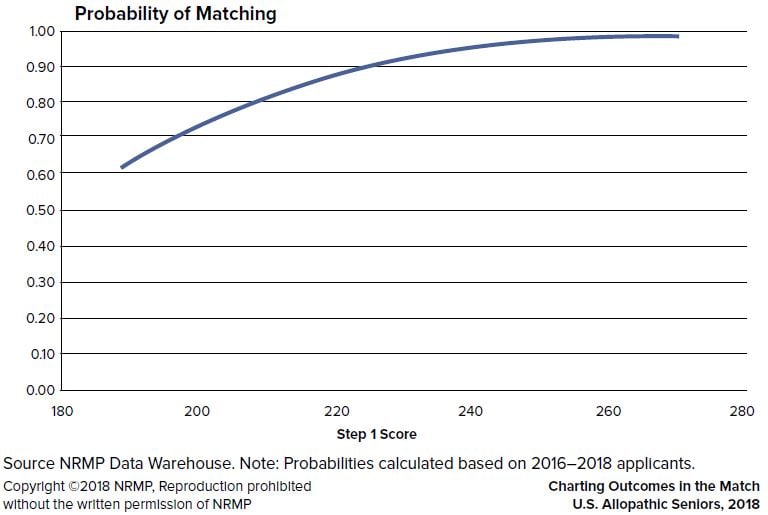
How important is USMLE Step 2 CK?
The 2018 NRMP Program Director survey suggests that the USMLE Step 2CK/COMLEX Level 2 CE is just as an important — if not more so — than USMLE Step 1/COMLEX Level 1.5
The number of programs that require completion of Step 2 CK in order to offer an interview is unclear — surveys indicate as few as 5%10 but up to 48%.5 Your safest bet is to complete Step 2 CK in time for your score to be released by Oct. 1.
Osteopathic Students: Taking and doing well on USMLE Step 2 CK can really bolster your application and help you be viewed on an even playing field when comparing numbers apples to apples.
At-Risk Candidates: To improve their chances of being considered for an interview, students with a lower USMLE Step 1 score should plan to study for and take USMLE Step 2 CK in time to have the score available when ERAS opens on Sept. 15.
What is a good score on USMLE Step 2 CK for applying to EM?
- Marginally Competitive Candidates: < 210 (including failed USMLE Step 2 CK attempt)
- Less Competitive Candidates: 211–239
- Competitive Candidates: 240–259
- Very Competitive Candidates: > 260
How important are my preclinical and clinical grades?
While basic sciences grades have been ranked lower in terms of importance to residency programs, performance in required third-year clerkships are cited as being heavily valued in multiple studies.5,9
EM rotation grades have been cited as very important to program directors year after year.5,9 However, grade alone does not translate directly into a certain level of competitiveness. While the traditional grade breakdown is Honors/High Pass/Pass, some schools only give Pass/Fail or sometimes Honors/Pass/Fail grades. Schools also vary widely in terms of grade distribution (percentage of Honors vs High Pass vs Pass grades), which is reported on SLOE. So while a Pass grade generally equates to lower competitiveness, this may not be the case on a Pass/Fail rotation or on a rotation with a very high percentage of Pass grades. Likewise, an Honors grade generally equates to higher competitiveness, but this may not be the case if the majority of students at this institution obtain an Honors on their rotation.
For both third-year and EM clerkships, an upward progression of grades through rotations will be well received and a downward progression may be more poorly received.
How important are extracurricular activities when applying to EM?
Extracurricular activities are a good way to show yourself as an individual and display what mattered enough for you to volunteer your time. This often comes up during interviews, so be ready to discuss anything you are listing. Leadership roles and involvement in medical school administration or interest groups can convey your dedication and work ethic. Focus on extracurricular activities that demonstrate leadership, commitment and hard work. It is doubtful that any one of these activities, on their own, actually predicts success or competitiveness in EM, though some programs will view these experiences favorably.
How important are work experiences when applying to EM?
Generally, EM-related endeavors help augment your application. Examples of these may include work as a scribe in an ED, work as an EMT or paramedic, or other work in the health care field. Prior jobs incorporating multi-tasking and customer service skills, such as waiter or waitress, may also be viewed as helpful. However, it is worth noting that prior work experience is not viewed as a heavily influential factor in inviting applicants for interviews or for selecting candidates for ranking.5 It is also worth noting that most candidates who successfully match into EM have at least one or more work experience listed, with an average of 3.5 work experiences.1
How important is research when applying to EM?
The amount of research experience is not generally very influential in determining the competitiveness of a candidate.5,9 However, this will vary from program to program. Programs with prominent research efforts may place emphasis on research. Four-year residency programs also place a greater emphasis on research and publications compared to three-year programs.9 It is important to note that most candidates who successfully match into EM have at least one research experience, and an average of 2,5,1 though not all of this research pertains to EM.
Military Match: Research is typically more important in military applications than civilian as this is given a high degree of weight in the military “point system.”
IMG Students: A 2018 poll indicates that research is not weighted as highly as previously indicated.6
How many volunteer experiences should I have when applying for EM?
Volunteer experiences are not overly influential in determining your competitiveness.5 However, they are tracked in ERAS, and candidates who successfully match into EM have an average of 7.3 volunteer experiences.1
What red flags might significantly change my level of competitiveness?
- Academic struggle, such as failed Step 1 or Step 2 CK or failure of a clinical or preclinical course
- Unexplained gaps in medical education or unexplained intervals in the CV
- Professionalism issues, academic misconduct, or clerkship failures
- Criminal convictions, including felonies or misdemeanors
At-Risk Candidates: While not all of these carry equal weight, any one of them can negatively affect your application. A 2018 survey suggests that academic misconduct is most concerning, with 100% of residency leadership respondents never or rarely interviewing these candidates. The next most concerning red flag was clerkship failure, with 94% never or rarely interviewing these candidates.6
So, how competitive am I?
This chapter has attempted to break up the separate components of your application and classify each in terms of relative competitiveness. You can generally view each individual component as additive towards an overarching level of competitiveness, though some components may be weighted more heavily than others, and weighting is program-dependent. As you read this next section, remember it’s more likely than not that you fall into the competitive category!
The following competitiveness-based recommendations take into consideration the data cited thus far as well as the AAMC’s graph on the point of diminishing returns for entering an EM residency program for U.S. MD applicants (Figure 8.4). The AAMC defines the point of diminishing returns as “the point at which the value added by submitting one additional application is reduced relative to the value added by each application.”3 Please remember the following recommendations are general guidelines and should never replace advice from an experienced EM-specific advisor who is familiar with you and your application’s strengths and weaknesses.
FIGURE 8.4. Point of Diminishing Returns for Entering an EM Residency Program for U.S. MD Applicants3
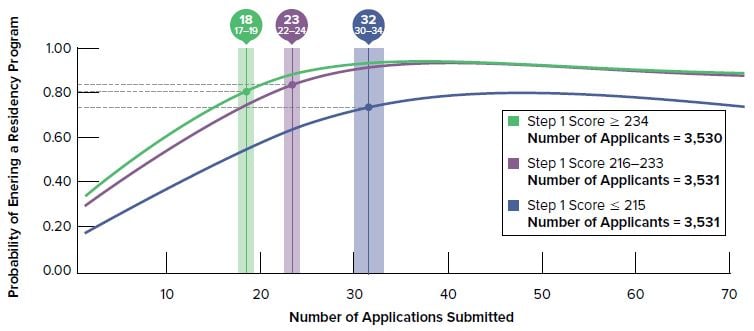
Source AAMC Data Warehouse: ERAS file accessed on May 1, 2017.
The following recommendations for number of applications are considerably lower than the average number of applications per applicant to EM (57.7 according to AAMC’s 2019 preliminary data)14 and represent an area where applying strategically rather than in larger numbers will have a better return on investment.
Marginally Competitive
Your application will have some of the following criteria but likely will not overlap that of any other category:
- USMLE Step 1: < 200
- USMLE Step 2 CK: < 211
- Only 1 EM rotation with no higher than a passing grade*
- No SLOEs or a SLOE that is not supportive
- Little or no exposure to EM in extracurricular projects or interest groups
- Presence of a red flag: academic struggle (failed Step 1 or Step 2 CK, failure of a preclinical course or clerkship), gaps in medical education or CV, professionalism issues, academic misconduct, criminal convictions
How this affects your application strategy:
- You may not be well-suited for a residency in emergency medicine or may have to overcome significant obstacles. You should consider a search for alternative plans to emergency medicine (apply to a different residency type altogether), but may consider a parallel plan if you strongly desire (simultaneously apply to both emergency medicine and a different residency type as a backup/alternate).
- You may be tempted to apply to as many rotations and residency programs as possible. However, the return on this time and monetary investment may fall very short of expectations. If you are a marginally competitive candidate, seek guidance from both an EM advisor and a general academic advisor to develop an appropriate application strategy.
Less Competitive
Your application likely will have some of the following components and none of the components of a competitive or very competitive candidate:
- USMLE Step 1: 200–219
- USMLE Step 2 CK: 211–239
- Fewer than 2 SLOES supporting a residency in EM
- Passing grades on EM rotations or a combination of Pass and High Pass grades*
- Has limited exposure to EM through extra-curricular projects or interest groups
How this affects your application strategy:
- You may be well-suited for emergency medicine but should develop a residency search strategy with an experienced, dedicated, EM-specific advisor in order to optimize chances and align resources.
- Survey data of EM residency program leadership and advisors indicate that 72% of individuals would advise candidates in this category to apply to about 31–50 programs.12 See Figure 8.5 for further breakdown of recommendations from this survey for an applicant that falls into the Less Competitive category.
- You should plan to apply to about 35–45 programs.
Osteopathic Students: Do not be deterred if you fall in this category. Just focus on finding an EM advisor and researching historically osteopathic friendly programs. Your likelihood of matching is still very high if you apply smartly.
Competitive
The vast majority of applicants fall into this category! Your application will have at least 2 or more of the following components, but also may have some criteria of a very competitive or less competitive candidate:
- USMLE Step 1: 220-239
- USMLE Step 2 CK: 240-259
- 2 SLOES that support a residency in EM
- A combination of Pass, High Pass or Honors grades on an EM rotations*
- Demonstrated commitment to EM in EM-related volunteer, research, or work projects
How this affects your application strategy:
- You are well-suited for a residency in emergency medicine and have a good chance at matching in emergency medicine. General advising resources will apply to you, though an EM-specific advisor is best at guiding you to success.
- Survey data of EM residency program leadership and advisors indicate that 85% would recommend candidates in this category apply to about 21–40 programs.12 See Figure 8.5 for further breakdown of recommendations from this survey for an applicant that falls into the Competitive category.
- You should plan to apply to about 20–30 programs.
Very Competitive
Your application will have 2 or more of the following components:
- USMLE Step 1: > 240
- USMLE Step 2 CK: > 260
- 2 SLOEs that strongly support a residency in EM
- High Pass &/or Honors grades on 2 EM rotations*
- Demonstrated commitment to EM in EM-related volunteer, research, or work projects.
How this affects your application strategy:
- You have a very good chance at matching in emergency medicine and general advising resources and advice will apply to you, though an EM-specific advisor is best at strategizing for success. An applicant in this category should pursue their interests in the specialty and follow usual advice for the match.
- Survey data of EM residency program leadership and advisors indicate that 97% would recommend candidates in this category apply to about 11–30 programs.12 See Figure 8.5 for further breakdown of recommendations from this survey for an applicant that falls into the Very Competitive category.
- You should plan to apply to about 15–25 programs.
*Some schools only give Pass/Fail grades or administer a very low percentage of High Pass & Honors grades. Letter readers will be able to see this and determine your performance based on other components of the SLOE, including comparison to your peers, but a Pass/Fail only course makes it more difficult to determine your own competitiveness. In this situation, it is especially important to ask your letter writer if they will be able to write you a supportive letter.
Couples Match: In a 2018 survey, a majority of EM faculty advisors recommend applying to a minimum of 31–50 programs when an “average” EM applicant is participating in the couples match (defined as high pass/honors grades, first-pass USMLE Step 1 score of ~230, 1–2 scholarly projects, and no red flags).6 Consider applying to geographic locations with multiple programs in both of your specialties.
Military Match: Given the small number of military residencies, military students are encouraged to apply to ALL available military programs.
At-Risk Candidates: Consider the perceived competitiveness of a program to make sure you are applying to programs that are realistically within your reach. Assessing competitiveness is more of an art than a science, but there are several questions you can ask to help make this assessment. First, is the program in a highly desirable place to live? Second, does the program have “name brand” recognition that would look impressive on your CV? And third, is the program “EM famous” for their faculty or their longevity within the specialty? The more "yes" answers, the more applications the program is likely to receive, and the more competitive the applicant pool for the program is likely to be. You should not refrain from applying to traditionally “competitive” programs, though it may be a good idea to consider these programs as a reach and not include them in your overall number count for applications.
FIGURE 8.5. Number of Applications Recommended by EM Advisors for Applicants Based on Competitiveness (n=200)12
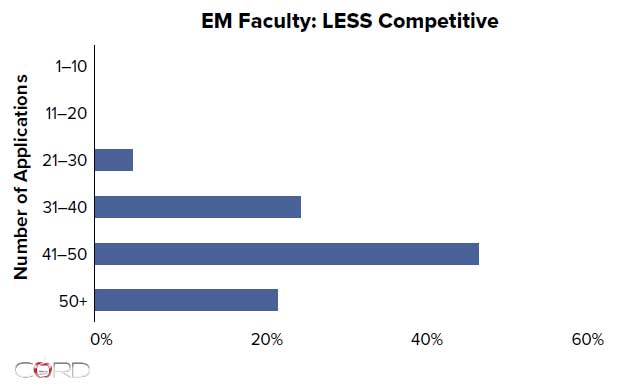
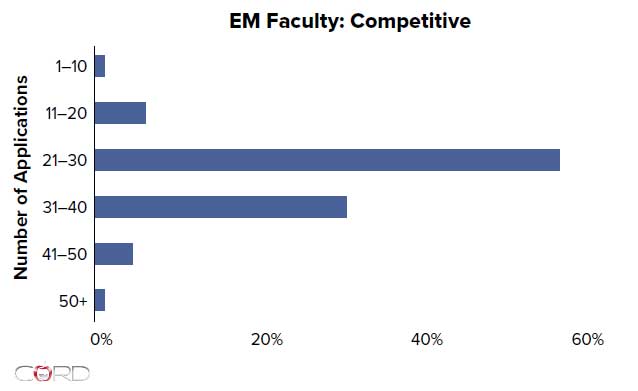
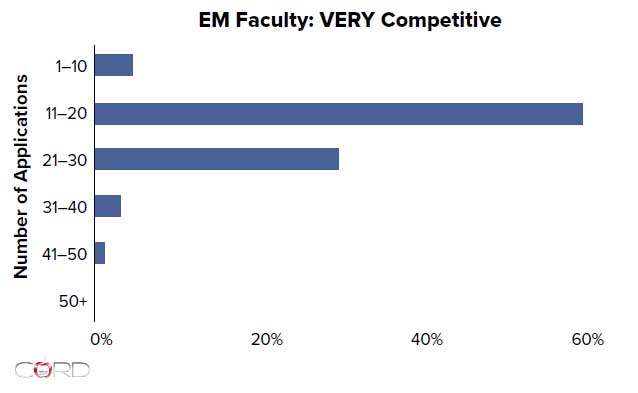
Tips for Increasing Competitiveness
There are many elements under your control, but by the time you apply to EM, some of them might already be settled. In that case, try these tips:
- Prepare for and do well on the USMLE Step 2 CK early enough that it can be included in your ERAS application at the time of submission in mid-September.
- Perform at your best during your EM rotations and obtain feedback from early EM rotations and mentors to augment your performance on future rotations.
- Rotate at 2 EM residency programs, ideally at your home institution and at an away institution. In some cases, a third rotation may be helpful, particularly if your home institution doesn’t have an EM residency or if you’re a less competitive applicant.
Military Match: Rotate and connect with as many military programs as possible.
- Find an advisor in EM to help you assess your competitiveness and identify strengths and weaknesses. Ideally this person should have experience in advising EM students, be part of core faculty of an EM residency program, and may be a clerkship director, program director, or associate program director.
Orphan Applicant: If your school isn’t affiliated with a training program or if it lacks EM faculty for advising, consider joining EMRA, SAEM, or other professional organizations. Through EMRA’s Medical Student Council, you can be paired with a resident mentor. Students can also participate in large-group virtual advising sessions through EMRA Hangouts every month. Keep in mind that you can also seek out advisors and mentors at programs where you rotate.
Osteopathic Students: Seek out early mentorship from someone connected in EM!
IMG Students: Mentorship in EM is always very helpful and helps keep you on track. The ACEP International Section offers a Rotation and Observation Database and can help connect you with a mentor.
Latecomers: If you are a latecomer to EM, then you likely have a previous advisor in another specialty. Outside advice will be helpful, but only EM-focused advisors will understand the entire process.
Consider participating in research, getting involved in a national EM organization, and networking with EM physicians. The advice and networking that comes with these experiences can help you as much — or more than — the projects themselves.
TABLE 8.1. Recommendations Based on Competitiveness
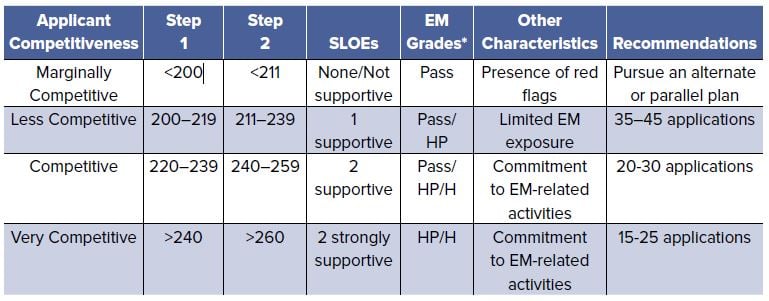
The Bottom Line
- The vast majority of applicants fall into the Competitive category — likelihood is that you do, too!
- In general, SLOEs tend to play the largest role in determining competitiveness.
- While great board scores can get you in the door, they are not as important when ranking — this is where intangibles like your interpersonal skills come into play.
- Your application, just like you, is multifaceted. There is no magic formula that guarantees success in the match. Work with your advisor to assess your own competitiveness by considering elements that are given the most weight by program directors and residency programs, as well as elements that have trended towards success in past matches.




